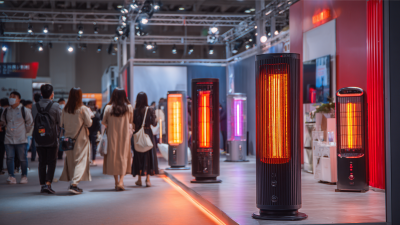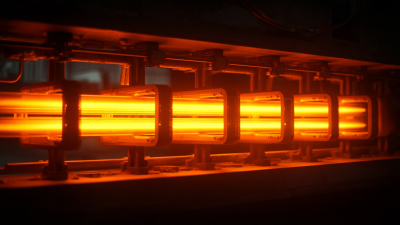FAQS
Optimal Warehouse Heating Solutions for Enhanced Energy Efficiency in Cold Storage Facilities
In the pursuit of maximizing energy efficiency within cold storage facilities, optimizing warehouse heaters plays a pivotal role. According to a report by the U.S. Department of Energy, industrial heating accounts for nearly 30% of energy consumption, with warehouse operations often amplifying these costs due to their large spaces and specific temperature requirements. Efficient heating solutions not only ensure product preservation but also significantly reduce utility expenses. A comprehensive study by the International Energy Agency highlights that implementing advanced heating technologies can lead to a potential reduction in energy use by up to 25%. As facilities grapple with increasing operational costs and sustainability mandates, incorporating smart heating systems and thermal insulation strategies is becoming critical. This article will explore various optimal heating solutions tailored for cold storage environments, providing practical tips to enhance energy efficiency and overall performance.

Identifying Key Energy Efficiency Challenges in Cold Storage Warehouses
Cold storage facilities face significant energy efficiency challenges, particularly amidst rising energy costs and a heightened focus on sustainability. With energy efficiency recognized as the "first fuel" in clean energy transitions, the need for optimized heating solutions in cold storage becomes paramount. Businesses must navigate various obstacles, including outdated infrastructure, rising operational costs, and stricter regulations. These factors compel operators to seek innovative technologies that can enhance energy efficiency without compromising on performance.
Moreover, the integration of IoT-based predictive analytics is reshaping the landscape of cold chain logistics, providing real-time data that can help identify inefficiencies in energy use. These analytics not only allow for better monitoring of energy consumption but also enable timely interventions to mitigate waste. As the demand for temperature-sensitive storage grows—especially in sectors such as e-commerce, pharmaceuticals, and food and beverages—the focus on developing renewable energy systems, along with advanced heating solutions, is critical to achieving sustainability targets while ensuring the reliability of cold storage operations.
Optimal Warehouse Heating Solutions for Enhanced Energy Efficiency in Cold Storage Facilities - Identifying Key Energy Efficiency Challenges in Cold Storage Warehouses
| Challenge | Impact on Energy Efficiency (%) | Proposed Solution | Estimated Savings (% of Energy Costs) |
|---|---|---|---|
| Inefficient Insulation | 25 | Upgrade to High-Performance Insulation | 15 |
| Poor Air Circulation | 20 | Install Advanced HVAC Systems | 10 |
| Inadequate Temperature Control | 30 | Implement Smart Thermostat Solutions | 12 |
| Energy-Intensive Lighting | 15 | Switch to LED Lighting | 8 |
| Frequent Door Openings | 10 | Install Air Curtains | 5 |
Exploring Advanced Heating Technologies for Warehouse Applications
In the realm of cold storage facilities, selecting the right heating technology is crucial for maximizing energy efficiency.
Advanced heating solutions like infrared heating systems are gaining traction, as they offer rapid and targeted warmth, reducing overall energy consumption.
According to a report by the U.S. Department of Energy, infrared systems can cut energy costs by up to 30% compared to traditional heating methods.
This efficiency not only lowers operational expenses but also minimizes the carbon footprint of warehouse operations.
Another innovative approach is the incorporation of heat recovery ventilation systems, which can reclaim up to 70% of the heat generated within the facility.
By using this recovered heat to warm incoming cold air, warehouses can maintain optimal temperatures while significantly lowering energy costs.
The Global Cold Chain Alliance reports that facilities implementing such technologies often experience a return on investment within two years due to decreased energy bills.
These advanced solutions not only promote sustainability but also enhance the overall operational efficiency of cold storage facilities, paving the way for a more energy-conscious industry.
Implementing Insulation Strategies to Enhance Thermal Performance
In cold storage facilities, implementing effective insulation strategies is critical to enhancing thermal performance and ensuring energy efficiency. According to the U.S. Department of Energy, improving insulation in warehouse environments can lead to a reduction of energy consumption by up to 30%. High-performance insulation materials, such as polyurethane foam or fiberglass, can significantly minimize heat loss during the winter months, maintaining the desired internal temperatures while reducing heating demands.

Furthermore, investing in proper insulation not only stabilizes temperature fluctuations but also contributes to operational cost savings. The Energy Information Administration reports that heating accounts for approximately 30% of energy usage in cold storage facilities. By selecting insulation solutions that have a high R-value, operators can effectively decrease the load on heating systems, leading to lower energy bills and a reduced carbon footprint. Facility managers should consider a continuous insulation approach, which eliminates thermal bridging and further enhances energy efficiency while creating a more comfortable storage environment.
Utilizing Smart Controls and Automation for Optimal Heating Management
In modern cold storage facilities, the integration of smart controls and automation is pivotal for optimizing heating management. As energy prices continue to rise, the necessity for efficient heating solutions has never been more critical. Implementing advanced building automation systems not only facilitates better control of heating environments but also significantly reduces energy consumption. These smart solutions leverage real-time data from sensors to adjust heating levels dynamically, ensuring that energy is used only as needed, thereby enhancing overall energy efficiency.

Furthermore, a growing emphasis on sustainability drives the adoption of smart building technologies. Facilities can track energy usage patterns, identify inefficiencies, and make informed decisions that contribute to carbon reduction targets. The projected growth of the global building automation market underscores the importance of these technologies in achieving optimized energy management and sustainability goals. As facilities increasingly adopt automation, they position themselves to benefit economically while also contributing to broader environmental objectives.
Evaluating the Benefits of Renewable Energy Sources in Warehouse Heating
In recent years, the need for energy-efficient heating solutions in cold storage facilities has become increasingly urgent, prompting a shift towards renewable energy sources. According to the U.S. Department of Energy, cold storage facilities account for approximately 11% of the energy consumption in the commercial building sector. By integrating renewable energy technologies such as solar thermal systems or geothermal heating, warehouses can significantly reduce their reliance on fossil fuels. Reports indicate that facilities utilizing solar heating systems can achieve energy savings of up to 40% when compared to traditional heating methods.
Evaluating the benefits of renewable energy not only addresses energy efficiency but also positions cold storage facilities to meet sustainability goals. A study by the International Energy Agency reveals that warehouses adopting renewable heating solutions can reduce greenhouse gas emissions by as much as 70%. This transition not only leads to cost savings on energy bills but also enhances a warehouse’s appeal to environmentally conscious clients. By investing in renewable energy sources, warehouses can enjoy long-term financial benefits while contributing to a greener future, highlighting that optimal heating solutions align both operational efficiency and corporate responsibility.
Optimal Warehouse Heating Solutions for Enhanced Energy Efficiency
This chart evaluates the energy efficiency of various heating solutions in cold storage facilities, comparing traditional heating methods with renewable energy sources.
Related Posts
-

Unlocking Warehouse Heaters Market Trends at the 138th Canton Fair 2025 in China
-

Portable Heaters Innovation Trends Unveiled at 2025 Canton Fair China 138th Session
-

Unlocking Industrial Efficiency: The Science Behind Infrared Heating Technology
-

How to Choose the Right Commercial Electric Heaters for Your Business Needs
-

How Infrared Bar Heaters Work: The Science Behind Efficient Heating Solutions
-

Maximize Your Outdoor Comfort: The Benefits of Propane Patio Heaters in Year-Round Use
 Skip to content
Skip to content
